Q: Why did you start Femgineers?
SH: Across the tech world, it’s pretty typical for women to be a minority, usually making up somewhere between 10%-20% of the overall engineering team. Even though Tinder is a really inclusive place, I thought we, the women behind the code, could use a little more focus. One of the first things I noticed when I joined the company two years ago was that we have really awesome ERGs (employee resource groups). There’s a Latinx-focused ERG, an ERG for Black employees, and even a Women at Tinder resource group, to name a few. What I was missing, though, was a subgroup specifically for women in engineering — it’s something we had at my previous company and we called it Femgineers there too. At the time, Tinder had a Slack channel, but not much was happening on it, due to the pandemic. I started making the group more active by setting up scheduled meetings and lunches. It was pretty casual, but I made sure that every meeting had a purpose, and wasn’t just another Zoom. If you identify as a woman and want to be part of what we call Femgineers, we’d love to have you!
Q: What gaps has this filled?
SH: It has been really important to have a space for engineers to come together, to provide a chance to talk, and to share successes or pain points, especially during the pandemic. It’s also a place for introducing resources specifically geared to this group. We ask what information or topics people want to discuss and we go from there, bringing in HR to talk about promotions, and inviting external speakers to talk about things like communication in the workplace. These are workshops that are generally available to everyone, but we are scheduling them and offering that private virtual room with just our fellow women engineers.
Q: Has anything surprised you?
SH: Even at an accepting place like Tinder, there’s something special about being in a space where other people have a fundamental shared experience that allows vulnerability. It has been fascinating to have conversations about working as women engineers. It was clear that we tend to have a much higher comfort level within teams where we work with other women, which is usually true for any minority group. Women who worked only with men or are working from home talk about feeling lonely. This is the sort of thing that comes up in this special setting, that’s unlikely to be said elsewhere, and that we can start to address proactively.
Q: What impact is the group having at Tinder?
SH: Tinder has a big focus on making sure the voice of women members is heard and Femgineers brought this into focus in three areas: product development, management, and the hiring process. Product development is a key area where we want women’s voices to resound. At the end of the day, we are the ones working with the design and product development teams and should have a say on the features. While we have a woman CEO and women represented in leadership, we would still like to see even more women in management positions. Representation matters to women envisioning their future at a company. We just want to grow in that domain. Management is not for everyone, but women should know that it’s an option for them here at Tinder. Finally, the hiring process is also on our radar — how to get women engineers involved in it. We want to make sure we’re encouraging more women engineers to join Tinder. Making sure women engineers have the skills necessary to join the hiring teams will help to show how diverse we really are so that we can attract more of us.
Q: How does Femgineers reflect your overall experience working at Tinder?
SH: For me, joining Tinder was an easy choice. I saw a big growth opportunity in becoming part of the security team two years ago as we were improving and revamping. It’s been an awesome ride so far. As the Director of Information Security and IT, I have about 25 people on my team, a third of whom are women. Tinder itself is a unique tech company because while we have a huge engineering team, compared to our market footprint, the company is small. That means we all have a really big role to play. Knowing that, we all support each other and make sure we’re clear on how to prioritize in a collaborative way. We’re extremely focused on getting work done and helping each other out. It’s a lot of fun.
Tinder is the kind of place where you see all different types of people at work. There are parents, grandparents, people at every stage of their career. It’s an inclusive place where people are passionate about making the product better and more accessible for everyone. This common goal of making dating and meeting people awesome for everyone out there is what unites us. Diversity and inclusion is something we believe in deeply because of how the company is built. We know that we need as many different perspectives as possible to make the product a welcoming space for everyone.


.JPG)


